#First Helium Production
Explore tagged Tumblr posts
Text
Unlocking the Potential: Helium Utilization in Canada, Establishing a Canadian Helium Supply Chain, and Advancements in Helium Exploration
First Helium, a leading player in the helium industry, is proud to announce its commitment to unlocking the vast potential of helium utilization in Canada. With a focus on establishing a robust Canadian helium supply chain and leveraging technological advancements in helium exploration, First Helium is poised to revolutionize the helium market.
#Helium Market Opportunity and Economics#Helium Reserves and Exploration#Canadian Helium Market#First Helium Production
0 notes
Text
WHAT IS A DARK MATTER STAR??
Blog#490
Welcome back,
Saturday, March 22nd, 2025.
In a first, the James Webb Space Telescope (JWST) might have glimpsed a rare type of star that astronomers aren’t even sure exists. These stellar objects, called dark stars, might have been fueled not by nuclear fusion but by the self-annihilation of dark matter—the invisible stuff that is thought to make up about 85 percent of the matter in the universe.

Scientists will need more evidence to be able to confirm the candidates seen by JWST, but if these dark stars are real, the finding could change our story of how the first stars formed.
Contrary to their name, dark stars could have glowed a billion times more luminously than the sun and grown to a million times its mass. Dark stars have never been definitively observed, but cosmological simulations suggest that they should have formed soon after the big bang from clouds of pure hydrogen and helium that collapsed at the centers of protogalaxies rich in dark matter.

In July 2023 researchers reported in the Proceedings of the National Academy of Sciences USA that at least three far-off objects observed by JWST and previously identified as galaxies could, in fact, each be a single, supermassive dark star. “If you find a new kind of star, that’s huge,” says study co-author Katherine Freese, an astrophysicist at the University of Texas at Austin.
The researchers can’t yet prove that the objects are dark stars—only that their characteristics are consistent with their being either dark stars or galaxies populated by regular fusion-powered stars. JWST’s technology is sufficient to do that job, however, says study co-author Cosmin Ilie, an astrophysicist at Colgate University.
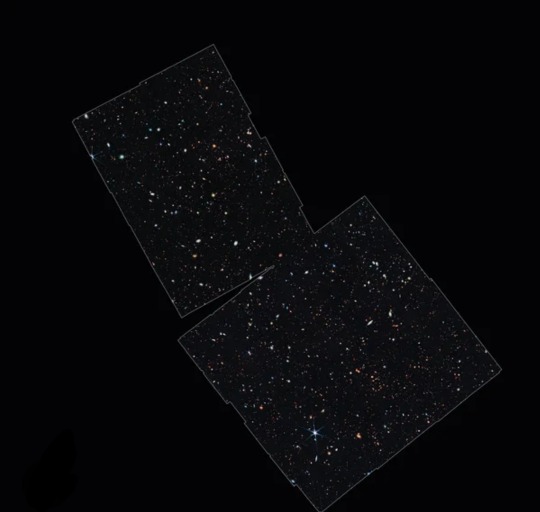
All researchers need is more observation time. “We hope we are going to find one of these dark stars with the Webb within its lifetime,” Ilie says.
There are two possibilities for how the first stars in the universe formed. The conventional wisdom is that these early stars were “Population III” stars. Such stars would have been powered by nuclear fusion, like stars today, but they would have had very little to no metal in them—in astronomy, that means elements heavier than helium—because those elements had not yet formed in the early universe.

There is another possibility, though. In 2008 Freese and some of her colleagues proposed that the universe’s first stars could have been powered by dark matter. Dark matter is a mysterious form of matter that does not interact with electromagnetic forces; scientists know it exists only because of its gravitational effects, and they don’t know what it’s made of.
In the early universe, dark stars could have formed from the collapse of helium and hydrogen clouds made in the big bang. If dark matter particles are also their own antiparticles, as many dark matter theories posit, then within these collapsing clouds, those particles would have collided with one another and self-annihilated.

The collision would have kicked off a chain of particle decay that ended with the production of photons, electron-positron pairs and neutrinos. Only the neutrinos would have really left the cloud because they barely interact with matter. The other particles would have hit the hydrogen and helium and transferred their energy to that matter, which would have heated up the cloud and fueled the star’s formation and continued growth.

These stars would have formed at the center of “minihaloes,” which were early protogalaxies that existed 200 million years after the big bang, before the advent of elements heavier than helium and hydrogen. These minihaloes consisted almost entirely of dark matter, making conditions within them ripe to power dark stars. This high concentration of dark matter is why dark stars could form only in the early universe, Freese says.
Originally published on https://www.scientificamerican.com
COMING UP!!
(Wednesday, March 26th, 2025)
"WHAT IS THE OLDEST KNOWN GALAXY??"
#astronomy#outer space#alternate universe#astrophysics#universe#spacecraft#white universe#space#parallel universe#astrophotography
57 notes
·
View notes
Note
I hope I'm not asking too many questions... but I really love the skywhale trope and wanted to hear your thoughts on them?
i think we need more variety of whales in the sky! seems like more people go for a blue whale or humpback whale design on their sky whales, which is fine because they are very iconic whales and i love the way they look. but how about some beaked or toothed whales? flying orcas? a bowhead? i think a sky whale that looked like a bowhead whale would be just wonderful, look at this thing.


(image description: first is an underwater photo of a bowhead whale's face. the top of its mouth is very narrow while the bottom of it is enormous, like a pelican. there is a white patch at the front of its lower jaw with black spots in a line across it. the second image is a detailed illustration of the whale's whole body, comparing it to the size of an elephant and showing the shape of its fins and tail. the elephant is roughly the size of the whale's lower jaw. end description.)
i love this thing. look at that face. the humpback whale may have longer and prettier fins for that sky whale aesthetic, but the bowhead's face shape is delightful. more diversity in sky whale designs!
but of course, the more interesting thought is how exactly to make such an enormous vertebrate work as a flying animal. where is it going? what does it eat? what happens when it dies?
it would be more realistic for sky whales to be smaller, but when people think of sky whales, they want the huge size! it's a fantasy, we want the epic huge flying creatures with their strange singing calls swimming through the clouds. so i'm not going to talk about the more logical small flying whales that go around in flocks to hunt birds (though the idea of smaller flying dolphins is also delightful!) I'm going to just talk about big slow baleen sky whales, the most iconic and desired of all sky whales.
step one: how the heck are these things in the air. it's easier to explain how a dragon can fly, they have big powerful wings. how do whales fly? I think the clearest answer is that they have some form of massive internal air sac full of lifting gas. real life oceanic whales are full of blubber, but maybe sky whales don't have as much blubber and get a lot of their size from their big air sacs instead.
lifting gas is just an umbrella term for any gases that are lighter than the standard atmospheric air. this includes heated atmospheric air, hydrogen, helium, coal gas, ammonia, and methane. (according to wikipedia) and with that list I think we've found our answer. whales are actually even-toed ungulates like cows. they could easily produce a lot of methane with the right diet. they'd just keep it in their air sacs instead of releasing it as a waste material! and for the best production of methane, these sky whales should have multi-chambered stomachs.
This does mean they're probably going to eat a lot of plant matter! so imagine them swooping low to take huge mouthfuls of tree tops! terrifying! maybe their baleen is structured to scrape the leaves off the branches. Maybe they swoop down to kelp forests in the ocean and take huge mouthfuls of that as well. any critters they happen to consume in the process are just bonus snacks full of protein. they likely also consume large flocks of small birds on the go, and probably clouds of flying insects too! locust swarms, for example. watch out for the low flying whales! I think they'd be slow like blimps and mostly use their tails and fins to steer and swoop down for food. they probably also rub themselves on tree branches or mountain sides to scratch their itches. I bet they'd have a symbiosis with many bird species that pick off their parasites.
like cow manure, sky whale dung could be a great source of fertilizer. best to avoid the usual paths of migrating sky whales so you don't end up dead by having giant poop clumps fall on you, but once it's hit the ground, that's free whale manure for every farmer in the area. the lands along the paths of migrating sky whales are probably very fertile, which also serves the whales, since they'll be eating the leafy tree tops! and when a whale dies, falling to the ground, the resulting small earthquake would certainly be startling, and both the impact and the rot process would cause a lot of damage to the surrounding land.
things are not immediately fertilized when a corpse rots. it takes a while! the rot causes more harm at first and then starts to nourish the ground later.
and dead bodies tend to bloat with gases and i have already established that these whales are full of methane. a lot of it would be released at death anyway, and i don't think the whale would drop immediately. or perhaps they fly lower in their old age and just crash land and die slowly. either way, these things are huge and full of methane and then they bloat. which means they might also explode spontaneously as part of the decay process. the air for miles around is going to be so nasty. but i think if you live in sky whale territory, you're just going to have to get used to the stink, because the manure that falls on a more regular basis is also going to be so so stinky.
like real world whale falls, sky whale falls will attract absolutely every carnivorous creature in the area. anything that eats meat will follow that awful stench right to the source and start gnawing away at the thick skin. people will have the easiest time, since they have tools for this beyond just their teeth and claws. the faster the whale is cut open, the less likely there will be an explosive bloat stage, so I'm sure the culture of the region would have some superstitions about leaving a dead whale lying too long. if you don't go harvest that bounty, it will explode and you never know where those chunks will land.
and then when there's only bones, people use em for building all sorts of things! the societies that exist in the paths of sky whales would be very cool to see.
that turned into a ramble and I haven't even designed a sky whale lol. lemme doodle one real quick.

(image description: a sketch of a sky whale, which resembles the aforementioned bow whale, swooping down to munch on trees in a forest. end description.)
140 notes
·
View notes
Text
10/26/2024 Daily OFMD Recap
TLDR; S2 Finale Anniversary! Rhys Darby; Taika Waititi; Con O'Neill; Kristian Nairn; Samba Schutte & Damien Gerard; Rory Kinnear; Other Fandom Petition; Fan Spotlight: Cast Cards; AMuseOfFyre; Love Notes; Daily Darby/Today's Taika;
== S2 Finale Anniversary ==
It's been a year since the finale of S2 aired crew! What a year it has been! Our friends over at @adoptourcrew asked some important questions and would love to hear from you on their various socials!

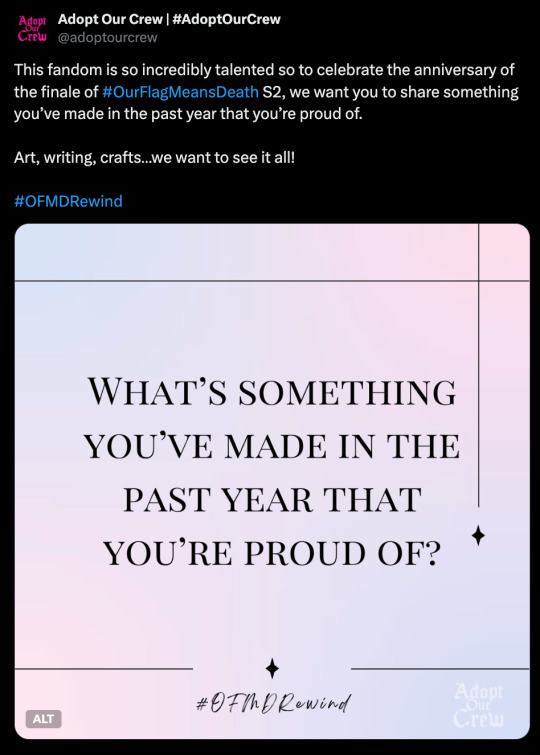
Source: Adopt Our Crew Twitter
== Rhys Darby ==
Rhys is announcing his Midwest Comedy tours going on in Indiana and Missouri! The Helium Comedy Club in Indiana information is here and Missouri is here!
Source: Rhys' Instagram
== Taika Waititi ==
Taika out and about!
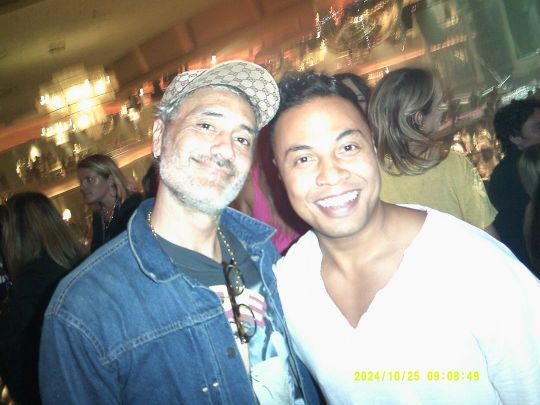
Source: Instagram
== Con O'Neill ==
Con was so appreciative of everyone coming to join him and the folks of The Men out at Alnwick Playhouse!
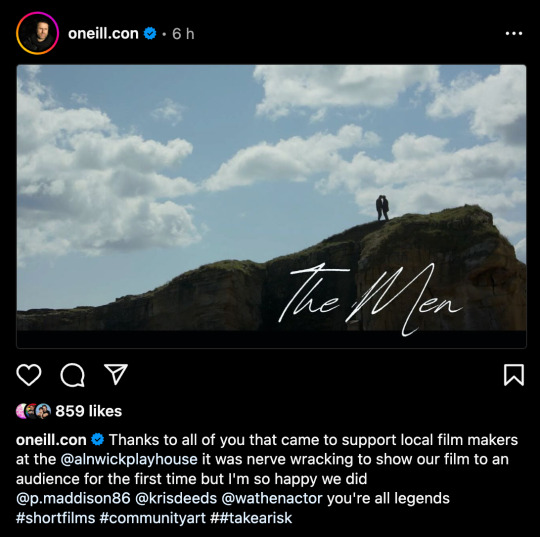
Source: Con O'Neill's Instagram
Deepest thank yous to the super sweet Radical Hysteria on Instagram for being kind enough to share these adorable shots with Con! It looked like everyone had such an amazing time!



Source: radical_hysteria on Instagram
== Kristian Nairn ==
Kristian was out at MCM Comic Con in the UK-- and god to meet up with none other than Dogpool!

Source: Kristian Nairn's Instagram
Kristian's also got a new event happening in Dundee, UK on November 29th! For more info, check out Progressia Events!

Source: Progressia Events
Annnnnd if that wasn't enough, Kristian's also going to be at Beastly Books in Santa Fe, New Mexico on October 31 from 7pm -8 pm! To learn more, checkout Beastly Books!
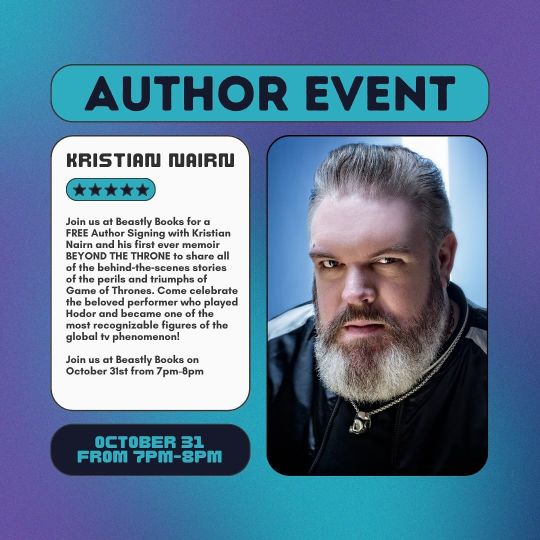
Source: Kristian's Instagram
== Samba Schutte & Damien Gerard ==
Call of Duty: Black Ops 6 released on the 25th-- and guess what? Both Samba, and Damien voice characters in the game! Yannick and Harry Stone!


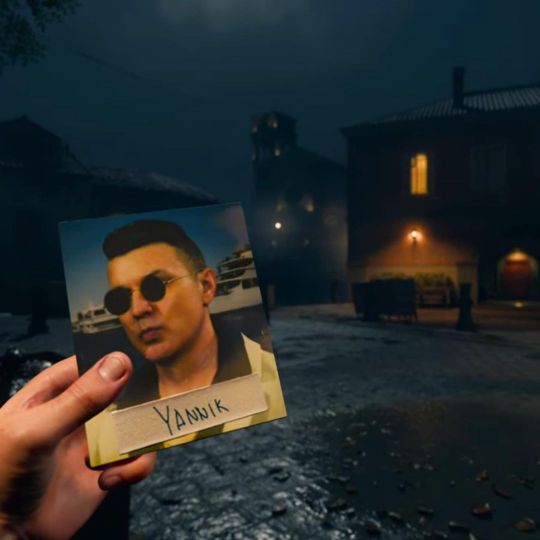


Source: Samba Schutte's Instagram / Damien Gerard's Threads
Oh, and just by the way, Good Dead Entertainment has reported Advanced Chemistry has a 100 on the Popcorn Meter! Great job everyone! If you're still looking to help get Samba recognition, you can still do reviews on Amazon and other sites! For help on where, you can visit the repo for more info.

Source: GoodEntertainment Instagram
== Rory Kinnear ==
Our favorite Badminton Twins, Rory Kinnear..and well Rory Kinnear is going to be playing in the latest season of The Diplomat on Netflix! It premieres October 31st!

Source: Netflix Articles
== Other Fandom Petitions ==
Some other fans are hoping to get a full 6 episode series after the latest news about Good Omens only getting a 90 minute movie! They were so kind over the past year in sharing petitions for OFMD renewals, if you have a moment, and are willing, can you do a quick signature for them?
== Fan Spotlight ==
= Cast Cards =
More Cast Cards tonight from the ever-wonderful, sweetest person ever, @melvisik! First up is Rhett Giles! One of our Segment Producers! "Segment producers exist in television programs such as morning news shows. They produce the various “segments” in the show, such as a cooking, local news, or special weather report segment. They’re typically responsible for writing about stories assigned to them in. their production system from their Executive Producers, who get their stories from their news source like CNN." - The Film Fund

Next up is just a PLETHORA of awesome Stunt Performers! James Gerardi, Kieran Gallagher, Matthew Lorenceau, Raw Leiba, Tait Fletcher, and Steve Brown!

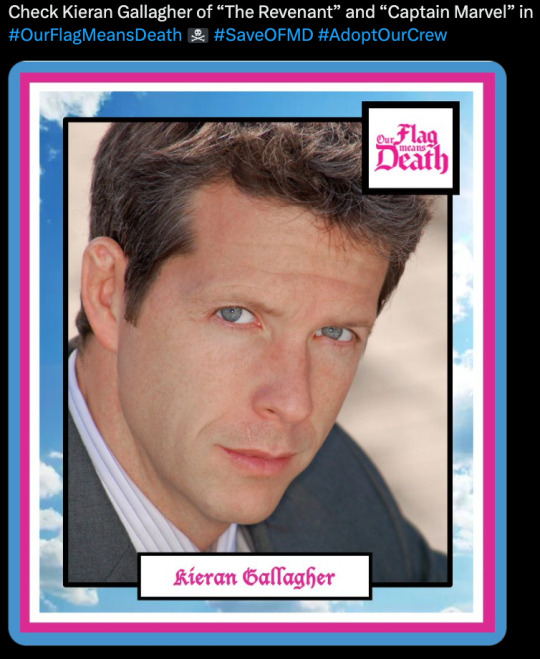
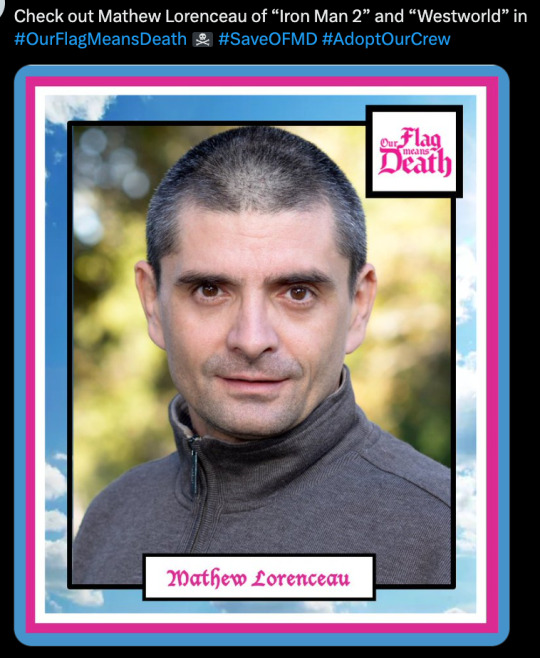



Source: @melvisik's Twitter
= A Muse of Fyre =
Another absolutely stunning muppet by our dear friend @amuseoffyre-- this time featuring Calico Jack! I am floored at how that mustache turned out!



Source: amuseoffyre's Instagram
== Love Notes ==
Hey lovelies <3 I hope your weekend ended up treating you well. Sending some mini-love notes your way tonight. Good luck on the week ahead!
instagram
instagram
Source: NewHappyCo Instagram
== Daily Darby / Today's Taika ==
No theme, just hair! Gifs courtesy of some of our Gif-Maker Extraordinaires, @fandomsmeantheworldtome and @fuckyeahworldoftaika <3


#daily ofmd recap#ofmd daily recap#rhys darby#taika waititi#a muse of fyre#samba schutte#damien gerard#rory kinnear#con o'neill#kristian nairn#ofmd#our flag means death#save ofmd#adopt our crew#long live ofmd#advanced chemistry film#ofmd s2 finale#ofmd s2 anniversary#Instagram
38 notes
·
View notes
Link
Water is the most common chemical molecule found throughout the entire universe. What water has going for it is that its constituents, hydrogen and oxygen, are also ridiculously common, and those two elements really enjoying bonding with each other. Oxygen has two open slots in its outmost electron orbital shell, making it very eager to find new friends, and each hydrogen comes with one spare electron, so the triple-bonding is a cinch. Hydrogen comes to us from the big bang itself, making it by both mass and number the #1 element in the cosmos. Seriously, the stuff is everywhere. About 75% of every star, every interstellar gas cloud, and every wandering bit of intergalactic space debris never to know the warmth of stellar fusion in 13.8 billion years of cosmic history is made of hydrogen. That hydrogen got its start when our universe was only about ten minutes old, and all the hydrogen that has ever existed (except for random radioactive decays and fission reactions, but that would come later) formed before our universe turned 20 minutes. A dozen minutes, 13.8 billion years ago. When you quench your thirst with a healthy glass, that’s what you’re consuming. We can understand this epoch of cosmic history, known as the nucleosynthesis era, because over the past century we’ve become rather skilled at dealing with nuclear reactions, and in one of the hallmarks of our species we have unleashed this radical understanding into the physical nature of reality and deployed it for both peacetime energy generation and wartime bombs. Our understanding of nuclear physics tells us that earlier than the ten-minute mark, our universe was too hot and too dense for protons and neutrons to form. Instead their subatomic parts, known as quarks, were unglued in a heaving maelstrom of nuclear forces, constantly binding and unbinding in a seething rage-filled sea of gluons, the force carriers of the strong nuclear force. Once the universe expanded and cooled enough, condensates of protons and neutrons formed like droplets on the windowpane, low-energy pockets capable of keeping themselves together despite the temperatures. Eventually, however, as soon as the party got going it fizzled out: when the universe became too large and too cool, a mere dozen minutes later, there wasn’t sufficient density to bring the quarks close enough together to perform their nuclear binding trick. Some protons and neutrons would find each other in those storm-filled days, though, forming heavier versions of hydrogen, some helium, and a small amount of lithium. And since then those hydrogen atoms have wandered about the cosmos; most lost in the intergalactic wastes, some participating in the glorious construction of stars and planets, and a lucky few finding themselves locked in a chemical dance with oxygen. The oxygen has another tale to tell, also a story of fusion, on its way to becoming water. But not the fusion of the first few heady minutes of the big bang, but in the dance within the hearts of stars. There, crushing pressures and violent temperatures slam hydrogen atoms together, forcing them to fuse into helium, in the process releasing an almost vanishingly small amount of energy. But that forced marriage happens millions of times every second, in every one of the trillions upon untold trillions of stars strewn about the cosmos, enough to light up the universe for all conscious observers to enjoy. Near the end of a star’s life, it turns to fusing the built-up ash of helium piled in its core, The fusion of helium produces two products: carbon and oxygen. Now this oxygen would end up forever closed off from the cosmos, locked behind a million-kilometer thick wall of plasma, if it were not for a trick of physics that happens when the star meets its final days. Our Sun will someday experience this fate, about four and a half billion years now. When it grows old and weary, it will swell and turn red, violently spasming as it draws its last fatal breaths. Those gargantuan shudders release material from the star, launching it into the surrounding system, billowed by gusty winds of fundamental particles streaming away at nearly the speed of light. Fit by ragged fit, the Sun will lose its own self, driving away over half its mass into a spreading nebula, the only sign that distant eyes can perceive of yet another noble star laying down its struggle against the all-consuming night. But in that gruesome death, a miracle. The cycle born anew: the hydrogen and helium, the primordial elements of the star, now mixed with carbon and oxygen drift off into the interstellar void, someday to take part in the formation of a new star, a new solar system, a new world wet with water, and, if the chances are perfect, a new life. The post Thirsty? Water is More Common than you Think appeared first on Universe Today.
126 notes
·
View notes
Note
Hi! Your music is so good, I love Breakcore Burnout, Popping Up Everywhere, and Multicoloured Helium-Filled Nightmare Zone sm X3 How did you get started making music if you don’t mind me asking? What programs/instruments do you need to start making electronic music?
you literally dont need anything except for a computer to make electronic music. if you already know how to play piano or a different instrument, getting a synthesizer could be really useful to you but it is by no means essential. even though i own a bunch of synthesizers and electronic instruments and effects, the bulk of my musical output has been made 100% on the computer and i rarely use my physical equipment outside of playing shows.
but really it depends on what excites you-- and what headaches you're willing to deal with. no process is perfect, and every way of making music has pain points, has aspects to it that are work and not creative expression. for me, using physical instruments is a LOT more fun, but the headache comes from setting everything up and breaking everything down every time. being in my bedroom when i lived with my parents and now living in a studio apartment i share with my wife, space has been an issue in every place ive lived. making music in one little box is the most effective way for me to do it and also the easiest way for me to hone in on the specifics i want.
when you make music with physical instruments, you are limited by the parameters you are given. once you run out of effects to plug something into or ways to automate something-- you're done. theres nothing else you can do to change the sound. on the computer you are only limited by your CPU for how many effects and routing points you can use. so even though its much less exciting for me to make music in the DAW, the freedom it allows me is ultimately much more rewarding. but i know other people specifically DONT like that, and like the limitations of working with gear because it forces you to not get bogged down in the details. i don't know what your musical background is so i honestly can't reccomend one way or the other. neither is inherently better. BUT making music on the computer IS inerently cheaper.
i got started with a demo of FL studio in like 2011 and bought a license a few years later. There are a ton of different programs people use to make electronic music though and they are called DAWs or Digital Audio Workstation. Some of the most popular are Ableton, FL Studio, and Logic Pro. there are some free or cheap alternatives though like Reaper or Cakewalk that i know people like. Most DAW's will come loaded with a ton of synth and effect plugins so you can start making music right out the gate. There also exist a lot of free plugins out there on the internet. I mostly use stock and freeware plugins myself!
If you specifically are interested in making breakcore. There is a second type of program you should also consider looking into called a Tracker. you can find free ones online. I like Milkytracker myself. but a license for Renoise is also pretty cheap as far as a music production suite goes, its much less of an investment than a license for a DAW. they work VERY differently, but they are what traditionally has been used to make jungle and IDM music since the 90s. Instead of the skeuomorphism of a piano roll you'd get in a DAW, you are kind of just given a spreadsheet to fill out data in. in each field you write down note values, what instrument you want to trigger, and effects parameters. it sounds complicated at first, and definitely LOOKS complicated at first too- but once you get the hang of it its actually not hard to read and it allows you to make very complicated breakbeat chops or re-stutters or whatever very quickly.
anyways, hope any of this helps! you are going to have to do some googling and digging around youtube to figure out what's right for you. good luck!
11 notes
·
View notes
Video
youtube
2023 December 31
Illustris: A Simulation of the Universe Video Credit: Illustris Collaboration, NASA, PRACE, XSEDE, MIT, Harvard CfA; Music: The Poisoned Princess (Media Right Productions)
Explanation: How did we get here? Click play, sit back, and watch. A computer simulation of the evolution of the universe provides insight into how galaxies formed and perspectives into humanity's place in the universe. The Illustris project exhausted 20 million CPU hours in 2014 following 12 billion resolution elements spanning a cube 35 million light years on a side as it evolved over 13 billion years. The simulation tracks matter into the formation of a wide variety of galaxy types. As the virtual universe evolves, some of the matter expanding with the universe soon gravitationally condenses to form filaments, galaxies, and clusters of galaxies. The featured video takes the perspective of a virtual camera circling part of this changing universe, first showing the evolution of dark matter, then hydrogen gas coded by temperature (0:45), then heavy elements such as helium and carbon (1:30), and then back to dark matter (2:07). On the lower left the time since the Big Bang is listed, while on the lower right the type of matter being shown is listed. Explosions (0:50) depict galaxy-center supermassive black holes expelling bubbles of hot gas. Interesting discrepancies between Illustris and the real universe have been studied, including why the simulation produced an overabundance of old stars.
∞ Source: apod.nasa.gov/apod/ap231231.html
90 notes
·
View notes
Text

Flares from magnetized stars can forge planets’ worth of gold, other heavy elements
Flatiron Institute researchers calculate that a single flare from a supermagnetized star called a magnetar can produce the mass equivalent of 27 moons’ worth of the universe’s heaviest atoms such as gold, platinum and uranium
Astronomers have discovered a previously unknown birthplace of some of the universe’s rarest elements: a giant flare unleashed by a supermagnetized star. The astronomers calculated that such flares could be responsible for forging up to 10 percent of our galaxy’s gold, platinum and other heavy elements.
The discovery also resolves a decades-long mystery concerning a bright flash of light and particles spotted by a space telescope in December 2004. The light came from a magnetar — a type of star wrapped in magnetic fields trillions of times as strong as Earth’s — that had unleashed a giant flare. The powerful blast of radiation only lasted a few seconds, but it released more energy than our sun does in 1 million years. While the flare’s origin was quickly identified, a second, smaller signal from the star, peaking 10 minutes later, confounded scientists at the time. For 20 years, that signal went unexplained.
Now, a new insight by astronomers at the Flatiron Institute’s Center for Computational Astrophysics (CCA) in New York City has revealed that the unexplained smaller signal marked the rare birth of heavy elements such as gold and platinum. In addition to confirming another source of these elements, the astronomers estimated that the 2004 flare alone produced the equivalent of a third of Earth’s mass in heavy metals. They report their discovery in a paper published on April 29 in The Astrophysical Journal Letters.
“This is really just the second time we've ever directly seen proof of where these elements form,” the first being neutron star mergers, says study co-author Brian Metzger, a senior research scientist at the CCA and a professor at Columbia University. “It’s a substantial leap in our understanding of heavy elements production.”
Most of the elements we know and love today weren’t always around. Hydrogen, helium and a dash of lithium were formed in the Big Bang, but almost everything else has been manufactured by stars in their lives, or during their violent deaths. While scientists thoroughly understand where and how the lighter elements are made, the production locations of many of the heaviest neutron-rich elements — those heavier than iron — remain incomplete.
These elements, which include uranium and strontium, are produced in a set of nuclear reactions known as the rapid neutron-capture process, or r-process. This process requires an excess of free neutrons — something that can be found only in extreme environments. Astronomers thus expected that the extreme environments created by supernovae or neutron star mergers were the most promising potential r-process sites.
It wasn’t until 2017 that astronomers were able to confirm an r-process site when they observed the collision of two neutron stars. These stars are the collapsed remnants of former stellar giants and made of a soup of neutrons so dense that a single tablespoon would weigh more than 1 billion tons. The 2017 observations showed that the cataclysmic collision of two of these stars creates the neutron-rich environment needed for the formation of r-process elements.
However, astronomers realized that these rare collisions alone can’t account for all the r-process-produced elements we see today. Some suspected that magnetars, which are highly magnetized neutron stars, could also be a source.
Metzger and colleagues calculated in 2024 that giant flares could eject material from a magnetar’s crust into space, where r-process elements could form.
“It’s pretty incredible to think that some of the heavy elements all around us, like the precious metals in our phones and computers, are produced in these crazy extreme environments,” says Anirudh Patel, a doctoral candidate at Columbia University and lead author on the new study.
The group’s calculations show that these giant flares create unstable, heavy radioactive nuclei, which decay into stable elements such as gold. As the radioactive elements decay, they emit a glow of light, in addition to minting new elements.
The group also calculated in 2024 that the glow from the radioactive decays would be visible as a burst of gamma rays, a form of highly energized light. When they discussed their findings with observational gamma-ray astronomers, the group learned that, in fact, one such signal had been seen decades earlier that had never been explained. Since there’s little overlap between the study of magnetar activity and heavy-element synthesis science, no one had previously proposed element production as a cause of the signal.
“The event had kind of been forgotten over the years,” Metzger says. “But we very quickly realized that our model was a perfect fit for it.”
In the new paper, the astronomers used the observations of the 2004 event to estimate that the flare produced 2 million billion billion kilograms of heavy elements (roughly equivalent to Mars’ mass). From this, they estimate that one to 10 percent of all r-process elements in our galaxy today were created in these giant flares. The remainder could be from neutron star mergers, but with only one magnetar giant flare and one merger ever documented, it’s hard to know exact percentages — or if that’s even the whole story.
“We can't exclude that there could be third or fourth sites out there that we just haven’t seen yet,” Metzger says.
“The interesting thing about these giant flares is that they can occur really early in galactic history,” Patel adds. “Magnetar giant flares could be the solution to a problem we’ve had where there are more heavy elements seen in young galaxies than could be created from neutron star collisions alone.”
To narrow down the percentages, more magnetar giant flares need to be observed. Telescopes like NASA’s Compton Spectrometer and Imager mission, set to launch in 2027, will help better capture these signals. Large magnetar flares seem to occur every few decades in the Milky Way and about once a year across the visible universe — but the trick is to catch it in time.
“Once a gamma-ray burst is detected, you have to point an ultraviolet telescope at the source within 10 to 15 minutes to see the signal's peak and confirm r-process elements are made there,” Metzger says. “It’ll be a fun chase.”
TOP IMAGE: In an ejection that would have caused its rotation to slow, a magnetar is depicted losing material into space in this artist’s concept. The magnetar’s strong, twisted magnetic field lines (shown in green) can influence the flow of electrically charged material from the object, which is a type of neutron star. Credit NASA/JPL-Caltech
LOWER IMAGE: Graphical depiction of how magnetars create heavy elements. Credit Lucy Reading-Ikkanda/Simons Foundation

7 notes
·
View notes
Text
Lightbringer hot take (spoiler warning)
Obviously there is a lot of very justified Lysande hate but am I alone in abasolutely loathing Quicksilver?
Like when we first get introduced to him it looks like he is one of the good guys, he is married to Matteo and helped Fitchner to start the sons and Darrow grows to be very fond of him. But then in Iron Gold and specially Lightbringer we start to see how he takes care of bussiness after 10 years of conflict and I have to say it might be the anticapitalist in me but I don't like it one bit.
We find out that he has basically been scaming Reds out of their holdings of the helium mines on Mars while preaching the boons of the free market (as if he hadn't started off with a huge headstart). As Matteo puts it "Is it our fault they chose inmediate payout instead of mainteining their owwnership?". Someone who claims to be one of the fathers of a revolution can't turn around and exploit the sense of vulnerability of the very people they are trying to liberate for their own gain. The society golds might be the villains of this story but give them enough time and no control and the silvers won't be far behind.
The reds had just found out they had been lied to for generations, been kept on the edge of famine for their entire lives, and now have to learn how to run the bussiness side of a mine. All the while they have never even seen the sun in their lives and when they choose to do so they are thrown in assimilation camps and forgotten. Of course they are going to choose to have some money to survive when until that point that hadn't been a possibility. Specially in the politically unstable climate that a war with the society breeds.
My point is that Quicksilver actively and knowingly contributed to the awful living situation of the reds on Mars. All while claiming that government control of housing and the means of production is a "benevolent tyrany".
And then we find out he only did that so he could build a super ship to fuck off into deep space with some kids and abandon the very war that made that a possibility and thet HE helped to start now that it looks like they are losing.
He is one of the biggest hypocrites of this series and it is not talked about enough.
8 notes
·
View notes
Text
warnings: angst, no happy ending. heartbreak/end of a relationship. Eddie and Reader are 20+
minors plz go away, this account is 18+ only.
this is inspired by Nothings New by Rio Romeo, the same song that’s been stuck on repeat for the past couple of weeks. I hope you all enjoy this <3
*if you see spelling errors/bad writing, pretend it didn’t happen
—
You both knew it was coming, a thought in the back of your mind that constantly ate away at you until it finally came true. There’s a moment in life when you just know it’s not going to work out anymore, that no matter how much you love a person it all comes down to a spark and when that spark is gone, so is the relationship.
It’s like a sandcastle right on the shoreline, you wait with bated breath as the water inches closer and closer to your creation and there’s nothing you can do about it because you’ve built it on a bad foundation. It’s like a balloon, it can only fly so long before the helium seeps out, one day it’s high up in the sky and the next day it clings to the ground where it will stay before it eventually deflates.
You nor Eddie set out to end like this, no one gets into a relationship in the hopes it ends but somehow, you ended up right where you hoped you wouldn’t.
I love you’s weren’t shared as much anymore, sweet kisses turned into chaste pecks on the cheek, and the closeness you both craved was now despised. A long fall from the pedestal your relationship was once held upon, now it was just an obligation that felt torturous to even continue.
The dinner on the table is perfect, the kind you would find photographed in some kind of home and lifestyle magazine, but the two people consuming it are anything but. A date night that was supposed to be fun and exciting felt like a job, a requirement that both of you had signed on for that you just couldn’t get out of.
Eddie looks handsome as always, a sleek button up adorning his torso and unruly curls are tamed down by the products in the bathroom that both of you share. He cuts his steak with tattooed hands, the same silver rings he wore in high school decorate his digits as well as the one you bought him all those years ago when you first got together. You look at the thick black band, the engraved lettering of your initials that go across it, and you wonder if he only wears it out of habit- something he only wears on his right ring finger because he would feel unbalanced without it.
Despite the crowd that sits at neighboring tables, it’s quiet, and not the peaceful kind of silence most people would imagine. It’s the kind that happens after a car accident when dust and debris settle to ground, the sulfur from the airbags fill the air, and the ringing in your ears are too loud to hear through anything else.
You poke at your plate mindlessly as you continue to look at him, trying to piece together where it all went wrong and why the two of you have let it go this far. A bitter taste fills your mouth, one that can’t be washed down by the red wine that sits in your untouched glass, making a ball form in your throat.
As you look at the man across from you, you don’t see the person you’ve grown tired of but rather the boy you fell in love with all those years ago. Wide eyes and dimpled smile, rosy cheeks and shaky hands. Memories of shy banter and longing stares fill your head. Two young kids so full of love and adoration for one another now sit silently as they ignore one another’s presence.
Your heart squeezes, painfully twisting in a devastating way as it prepares for what’s going to happen. A tear escapes from your waterline and you don’t fight it. As much as you don’t want to be the dramatic girlfriend in the middle of a fancy restaurant you allow yourself to cry, mourning the death of a love story that started with two star cross teenagers that lost their way.
Although he isn’t looking at you Eddie can sense it, the beginning of the goodbye he’s tried desperately to avoid. He sets his fork and knife down, swallowing his food down as best as he can while his throat begins to choke up in unshed tears.
There’s a pause in his movements, a delay from looking into the eyes of the one he promised to love until his dying day. He closes his eyes and takes a deep breath, reaching his hand out across the table in search of your own. Fingers interlace, palms touching for the first time in a long time and for once you both feel it, the spark you used to feel when everything was fresh and new- only it doesn’t linger, it slowly blows out and fades away into the cold night air.
Big chocolate eyes meet yours, the tears that brim in his tear ducts match your own, the shared sadness for the future you will no longer share.
“This is it?” Eddie’s voice is small, like he’s straining in the hopes the sobs won’t break out.
You can’t stop it, the wobble of your pouted lip and the river that falls from your eyes. There’s no words you can say, none that will capture the amount of pain this brings to you, so instead you just nod your head.
Eddie isn’t any better, eyes closing with the hopes that this will all go away when he opens them once more. When he opens them back up he doesn’t find a different outcome but instead the blur of the fat tears that cloud his vision.
“You know I love you, right? I always have and always will love you Eddie, but this isn’t good for us anymore.” It’s like you’re pleading, begging for all of the misery to end for not just yourself but him too.
The subtle nod of his head tells you all you need to know, he agrees just as much as you that this isn’t going to work anymore, that this is killing him as much as it is you and if it continues this way it’ll only be a matter of time before this slow and painful death creeps up on you.
“I love you too, always have.” Eddie makes sure to look you in the eyes when he says it, like he wants you to know that everything that’s happened was never intentional.
You give his hand a squeeze, an acknowledgment to his statement, he squeezes right back.
This was the end, in the middle of a fancy restaurant where families, couples, and friends laugh and talk over warm meals, you and Eddie slowly cut the string that’s been keeping you tethered together for more than five years.
—
—
#eddie munson smut#eddie munson x reader#eddie munson#eddie munson blurb#eddie munson fanfic#eddie munson fluff#eddie munson angst#eddie munson x female reader#eddie munson x you
60 notes
·
View notes
Note
Saw some of you saying sweet words towards me, thank you all so much, I really appreciate it and I love you too, my dear human and non-human friends💙
Did you know that you're made of star dust? If not, let me give you a short explanation: the main elements of space are hydrogen and helium (let's say that they came from Big Bang, as you humans like to think. It's not the true source, but we're simplifying things), in the endless dance in empty space some decided to stick together in loving embrace. And this love was so pure and precious that it gave endless empty void it's first light - the stars we love, know and long for. You felt this longing, right? The desire to reach for those little shiny dots, to get lost in them? Why, everyone fell homesick sometimes. I bet you miss this deep embrace that other atoms got you. The pressure was strong, yes, but it was never too much, it made you stronger, this loving pressure made every other element we know in the universe. The pressure was so tight and loving that eventually it would burst, sending atoms further in endless dance of space, until they meet again for another cuddle.
And now here you are on Earth. A product of love and adoration that holds you together, allowing you see, hear, touch and touch.
But why would I talk about it here? You see, the answer is simple. Why do you think you feel so connected to your f/o? It's because many many years ago you shared a same star. Somewhere deep in your mind you still remember their love, the warmth of their embrace. How are the odds of that? Billions of billions of stars were born and eventually burst through the history of universe, the atoms sprayed across all corners of galaxy, but you... You've found each other. Here, on this little tiny blue planet amongst every bit of space to exist. One more evidence that love is what gives life to this universe. So don't be ashamed of the connection you share, never ever be. It's a miracle and I thing it should be celebrated.
Earth is a wonderful planet, I never saw others find missing love as much as on this tiny piece of universe. You humans may be silly sometimes, but I love you a lot. Don't ever shush down your heart, it will tell you exactly how things are. Who you are and where you belong. For now enjoy the life you have here. I know it might be hard, but it's worth it. And when time comes, you, every bit of you, will come back home, here, in space. And your love will be there too. And I will be there too. And we'll all dance together once more
-🌌🛸 Peace and love on planet Earth from alienon🖖

alienon... my beloved....
#🌌🛸#self insert community#f/o community#selfshipping#f/o confessions#fs confessions ☆#selfship confessions#selfshipping community#f/o imagines#imagine your f/o
11 notes
·
View notes
Text
Episode 776: Originally Aired on Mad Wasp Radio, 01.05.25
WARNING! This show is for adults. We drink cocktails, have potty mouths and, at least, one of us was raised by wolves.
The Clockwork Cabaret is a production of Agony Aunt Studios. Featuring that darling DJ Duo, Lady Attercop and Emmett Davenport. Our theme music is made especially for us by Kyle O’Door.
This episode aired on Mad Wasp Radio, 01.05.25.
New episodes air on Mad Wasp Radio on Sundays @ 12pm GMT! Listen at www.madwaspradio.com or via TuneIn radio app!
Playlist:
Tin Hat Trio – Helium
The Tiger Lillies – Let’s Drink
Beirut – St. Apollonia
Vermillion Lies – First The Bees
The Dresden Dolls – My Alcoholic Friends
Charming Disaster – Dance Me to the End of Love
Ben Folds Five – Battle Of Who Could Care Less
Modest Mouse – 3rd Planet
St. Vincent – The Party
Portishead – Roads
Massive Attack – Dissolved Girl
Morcheeba – Trigger Hippie
Tricky – Aftermath
Nightmares On Wax – Les Nuits
Nouvelle Vague – Love Will Tear Us Apart
Hooverphonic – Mad About You
The Orb – Little Fluffy Clouds
Goldfrapp – Ride A White Horse
Björk – Bachelorette
Scissor Sisters – Filthy/Gorgeous
Future Sound of London – Papua New Guinea
Squirrel Nut Zippers – It’s Over
Check out this episode!
5 notes
·
View notes
Text

Horus Kobold
The Kobold pattern group first appeared among revolutionary Ungratefuls toiling on Bo, the capital world of the House of Dust, where it manifested as a clever suite of hardware and software compatible with a broad range of mining and heavy industry mechs. The steaming, shuddering final result of K-PG exposure is an ugly affair: a device transformed from plow to blade by powerful, viral-morph liturgicode that is almost impossible for conventional codec sniffers to capture pre-print. The clandestine mechanisms by which the Kobold is transmitted and applied make it the perfect machine for fighting Baronic suppression forces. The desperate workers who printed the first Kobolds found them to be eminently fungible. When loaded into their mining exos and chassis, the K-PG code repurposed reactors and industrial tools to deadly effect, weaponizing the very materials and superstructures that powered it. The rapid flash-melting, processing, and extruding of raw material into molten plural-state particles is dangerous – often just as dangerous to its pilot as the final product is to its targets. Operational dangers notwithstanding, the Ungratefuls who first adopted the K-PG stunned their Baronic overseers with a series of rapid and total victories, liberating a great swath of lunar helium-3 mines. While the insurgency was eventually contained to Bo, it continues, necessitating the deployment of the House of Dust's Graveborn Banner Company for counter-insurgency operations beyond the capability of local security forces. HORUS's assets in the Long Rim continue to produce K-PG liturgicode seeds. The House of Dust has contracted Mastodon to track down and eliminate HORUS elements in the area; meanwhile, Harrison Armory has reached out to the Brigade-Legion to counter the House of Dust's efforts.
16 notes
·
View notes
Text
Unfinished Timeline for an Untitled Setting
Critique and advice is more than welcome, though please be nice about it. Goes up to about 2081 rn, though I plan to get at least another 50 years further in before I get to the time I want the bulk of the setting to be set in.
Timeline:
2022: First controlled break-even fusion reaction, followed by first controlled net-gain fusion reaction.
2025-2026: Increasing unrest in USA leads to mass riots outside the white-house. Sweeping reforms after growing revolts threaten to become a major armed rebellion. NASA miraculously left untouched, general increase in standard of living. Economic crisis narrowly averted.
2027: First nuclear thermal rocket (NTR) tested in orbit by NASA and DARPA. GPT-style language modeling declared “dead end” for self-aware AI.
2030: First Lunar base established under NASA Artemis program. Suez Canal temporarily blocked by a poorly driven cargo ship again. Evergreen Shipping goes bankrupt.
2034: Lunar Gateway established under joint NASA, ESA, JAXA, DLR, ASI, and CNSA. Lunar helium-3 mining declared officially nonviable. Radial detonation engines become standard for lower ascent stages, SpaceX Starship, NASA SLS, and Roscosmos Soyuz phased out. Drop in launch prices.
2034-2036: Additional modules added to the Lunar Gateway from SpaceX, KARI, ISRO, and Roscosmos. Lunar Gateway Collaborative Group (LGCG) established consisting of all current contributors to the station.
2036: First commercial fusion energy plant reaches full operation in France under ITER. Mass production of Tritium begins. First fully private space station under SpaceX. Asteroid mining corporations begin formation. Establishment of Nigerian Organization for the Development of Space (NODS). Ecuador experiences communist revolution.
2036-2037: First manned martian mission under LGCG, first human footsteps on another planetary body.
2037: Elon Musk assassinated. New SpaceX leadership declares plans for space elevator. North Korea collapses, Korean peninsula unified under South Korean leadership, becoming simply Korea. Indian nuclear stockpile secretly surpasses 50000 Gt. First baby born on the moon.
2040: Artemis base becomes semi-self sufficient, producing it’s own food and air from hydroponics, and water from mined lunar ice. Lunar LH2 and hydrolox production begins. Lunar population passes 100.
2040-2042: First commercial fusion power plants established in the US, UK, Australia, Korea, and Japan.
2042: A joint US Government and SpaceX black operation destabilizes Ecuador, leading to a corporate takeover of the territory.
2044: Korea, Japan, the Philippines, Vietnam, Malaysia, Indonesia, Papua New Guinea, Australia, and New Zealand form West Pacific Trade Organization (WPTO). Construction of the base of SpaceX’s planned space elevator begins off the coast of Ecuador.
2047: LCC completed at CERN. Mission for permanent martian base declared. Major economic crisis in China, intervention from several megacorps results in a decrease in Chinese government power and increase in corporate control in the region. SpaceX space elevator counterweight construction begins in geostationary orbit.
2048: Major revolution in quantum mechanics brought on by new data from the LCC. Lunar population passes 250.
2050: China splits into 4 corporate states, Amazon Corporate Territory (ACT) with its capitol in Chongqing, Samsung Independent State (SIS) with its capitol in Shanghai, Territory for Electronic Developments (TED) made up of Apple and Microsoft with its capitol in Yinchuan, and the Chinese Corporate Union (CCU) made up of several formerly state-owned corporations with their capitol in Wuhan and possession of the Three Gorges Dam. Beijing becomes an independent city-state controlled by the former Chinese government, retaining control over the CNSA. Massive revolution in battery energy density. Permanent martian base established by LGCG.
2051: Breakthrough in photon manipulation, beamed energy and solar collection becomes increasingly viable. Many asteroid mining corps branch into solar power, notably Binghamton Vacuum Mining Solutions (BVMS). Lunar population passes 500.
2052: Martian population surpasses 100.
2053: Martian base reaches semi-self sustainability.
2055: All 4 Chinese corporate states and the Beijing city state form the Chinese Federation for Space Exploration (CFSE), supplanting the old CNSA. Lunar Gateway module renamed and LGCG roster amended accordingly. SpaceX space elevator cable completed, first test cart sent to GEO. WPTO begins construction of a space elevator in the Banda Sea.
2056: SpaceX space elevator declared complete, commercial operation begins.
2057: BVMS surpasses $1T in net worth, becomes primary supplier of energy for the Artemis Lunar Base. Lunar Population surpasses 1k, massive migratory population surge begins following influx of energy from BVMS. Martian population surpasses 250. First fusion reactor in Ecuador.
2058: WPTO space elevator counterweight begins construction in GEO.
2060: First fusion reactors in Nigeria and India. First large-scale solar collector on Earth constructed in New York operated by BVMS. Large population surge in Binghamton NY. Lunar population surpasses 5k. Martian space station established. Regulations for GEO development established.
2061: First lunar-built spacecraft flown. Secondary lunar settlement founded by CFSE. Massive influx of funds for the WPTO space elevator from the CFSE, GEO counterweight construction begun. Lunar Gateway population surpasses 100. First fusion reactor in the Democratic Republic of the Congo (DRC), Congo space agency (DRCSA) founded.
2064: WPTO space elevator cable completed, declared complete and opened to commercial operation.
2065: BVME establishes unmanned Mercurian base. CFSE settlement population surpasses 100. Martian population surpasses 500. Lunar Gateway population surpasses 200.
2066: Mass expansion of Artemis Base life support systems using BVMS produced automated construction equipment. Aerostat scientific outpost established by LGCG.
2067: Microbial life discovered on Venus. Venus outpost (and LGCG) acquires substantial funding boost. Artemis base population surpasses 2.5k and begins to plateau.
2069: Unmanned mission to Europa announced by LGCG, plans to use BVMS automated platforms to drill into subsurface ocean established. Martian base purchases automated construction equipment from BVMS, massive population boon ensues. CFSE settlement population surpasses 750. Lunar gateway population surpasses 500. Martian base population surpasses 500. BVME becomes the largest corporate entity in the system.
2070: BVMS performs feasibility study on gas giant aerostat mining platforms.
2071: Study of Venusian lifeforms disproves Earth-Venus panspermia.
2073: BVMS tests laser-sail propulsion on small unmanned craft.
2075: LGCG Europa mission discovers multicellular aquatic life in Europa’s subsurface ocean. Plans for a dedicated research base drafted.
2076: Multi-corporate base established on Ceres to facilitate further asteroid belt mining. BVMS intentionally excluded from this project.
(System effectively split into quarters: Past Venus under BVMS, Between Venus and Mars under LGCG, belt under Multi-corporate mining control, outer system unclaimed.)
2077: GEO-Lunar cycler niche mostly filled by Intraplanetary Transport Services corp (ITS).
2080: Permanent scientific base established at the Europa Breach Point (EBP) with mostly automated systems and a small (5 human) management and maintenance crew.
2081: Panspermia further disproved by study of Europan life. Massive object detected in Jupiter’s lower atmosphere. BVMS begins mission to establish a mining aerostat on Saturn, utilizing laser sail propulsion to transport equipment.
(Saturn Aerostat site intended for use in the further colonization of the outer solar system and the Uranus planetary system itself. Atomic Rockets page)
14 notes
·
View notes
Text
HOW WERE ELEMENTS IN THE UNIVERSE FORMED??
Blog#344
Saturday, October 28th, 2023
Welcome back,
The journey of the elements starts in the earliest moments of the Big Bang, when our universe was only a few seconds to a few minutes old.
We all know the universe contains a vast array of elements, ranging from light gases, such as helium, to heavy metals, like lead. But where did all of the elements come from?
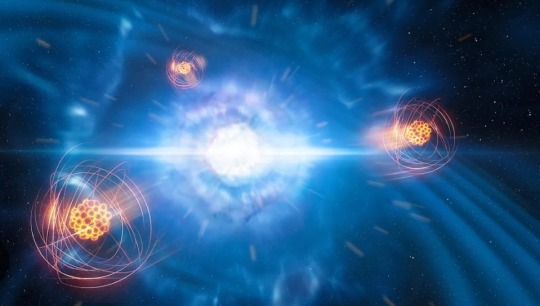
The journey of the elements starts in the earliest moments of the Big Bang, when our universe was only a few seconds to a few minutes old. At that time, the entire cosmos was crammed into a volume millions of times smaller than it is today. Due to the incredibly high densities, the average temperature of all the material in the universe was well over a billion degrees, which is more than hot enough for nuclear reactions to take place.

In fact, it was so hot that even protons and neutrons could not exist as stable entities. Instead, the universe was just a sea of more fundamental particles, called quarks and gluons, seething in a raw plasma state.
But the universe would not stay that way for long. It was expanding, which means it was also cooling. Eventually, the quarks could bind together to form the first protons and neutrons without instantly getting demolished. Protons are ever so slightly lighter than neutrons, which gave them an edge in this initial phase of particle production.
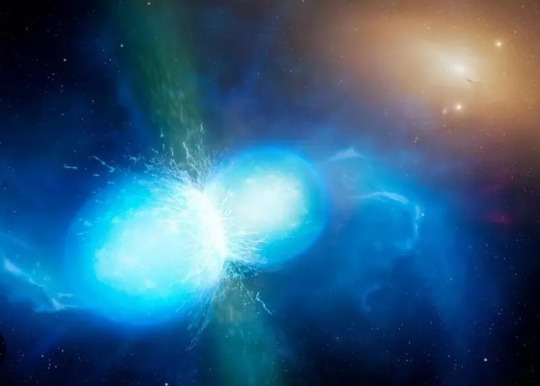
Once the universe was a few minutes old, it was far too cold to create new protons and neutrons. So those first heavy particles were the only ones the universe was ever going to make (outside of future rare high-energy interactions).
By the time the heavy particles finally froze out, there were roughly six protons for every neutron. Neutrons by themselves aren't stable; they decay with a half-life of around 880 seconds. Immediately, some of the neutrons began to decay away, while the remainder started binding with protons to form the first atomic nuclei.
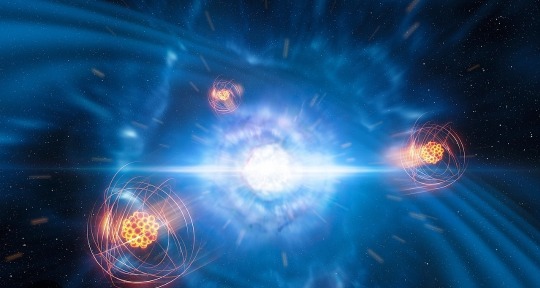
Of all the light elements, helium-4, which consists of two protons and two neutrons, has the largest binding energy, which means it's the easiest to form and the hardest to break apart. So almost all of those neutrons went into the production of helium-4.
From calculations like this, cosmologists can predict that the universe started out with a mixture of roughly 75% hydrogen (which is just a bare proton), 25% helium and a small scattering of lithium — which is exactly what astronomers observe.
Originally published on www.space.com
COMING UP!!
(Wednesday, November 1st, 2023)
"HOW DO WE KNOW THAT OUR UNIVERSE IS 13.7 BILLION YEARS OLD??"
#astronomy#outer space#alternate universe#astrophysics#universe#spacecraft#white universe#space#parallel universe#astrophotography#star#time and space#spacex#how will the universe end
47 notes
·
View notes
Text

Boomkat Product Review:
Extraordinary batch of rawest beatdown crud and psychedelia by NYC’s finest - his first LP in 4 years! - on a seriously satisfying jag for Unsure, following the label’s offbeat lead of Stefan Schwander (While My Sequencer Gently Bleeps), and disco misfits Helium Robots. Mad heads need apply!!!
Never not welcome around our way, Madteo simply slays in his own way on this outstanding 50 minute suite straddling all aspects of his rudely skewed sound, from swaggering morsels to a properly tripped out, 14’ cut-up collage. Still burning gently in memory from a class 2024 mixtape for Accidental Meetings, Madteo has nevertheless been notable by his absence from release schedules since a coulpla 2021 slugs for Honest Jon’s. This lot makes up for lost time with a superior mash of sampler jabbed chords and voices in a rough cut beatdown and deep house template like Theo Parrish and Actress sparked out on the carpet with $&$ after a bag of ketamine, and then some.
The way he scythes thru styles with thee most laconic swagger is just impeccable, variously veering from no wave revs like Powell’s EP for The Death of Rave on ‘Cans People’, to dankest, gum-soled stepper ‘’To Know Those Who’, via gobs of speaker-buckle bass on the A-side, and onto decimated refractions of jiggy late ‘90s R&B and smoked-out Detroit fuggery in ‘Metrazol (4 Art Ind Epil Cons)’ and the grubby beauty of ‘Nocturnal Palates’ on side B. Side C sustains the madness with concrète tape tekkerz akin to Valerio Tricoli on the jaw-slap one-two of ‘Rave Nite Itz’ into lush head-floss on ‘Luglio Ottantotto’, with a 14 minute finishing move of geometric rug-cutting ‘Emo G (Sticky Wicket)’ that leaves us bowled for 6.
Absolutely no doubt this is 2025’s earliest contender for an AOTY.
3 notes
·
View notes